Yesterday morning I found nine Swainson’s Hawks perched on utility poles. Eight of them were in pairs, with both birds of the pair perched together on the pole. Normally I don’t photograph raptors on poles, but I often scope them out through my lens in case there’s something interesting or unusual about them.
This pair got my attention so I did take some photos.
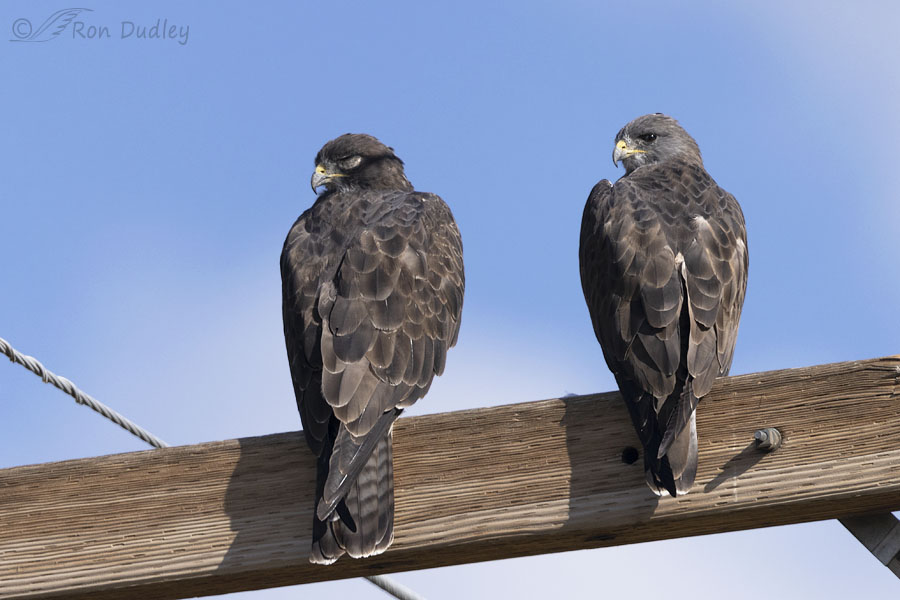
This is the first photo I took of them. I was curious as to why the bird on the left had its true eyelid closed. And kept it closed. At first I was concerned that it might be because of an eye injury or illness but soon…
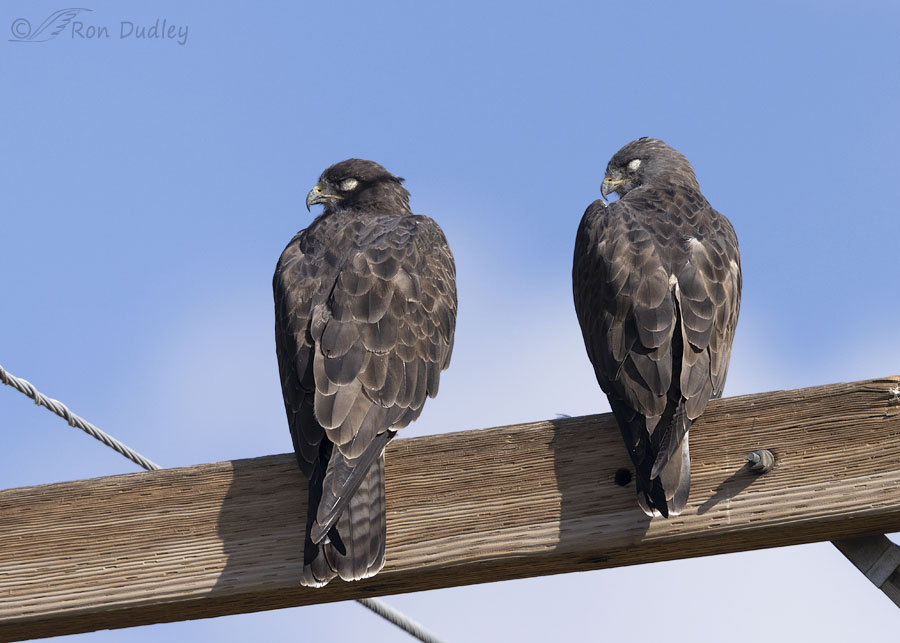
both birds were doing it. And they kept them closed for some time. I have lots of photos like this one.
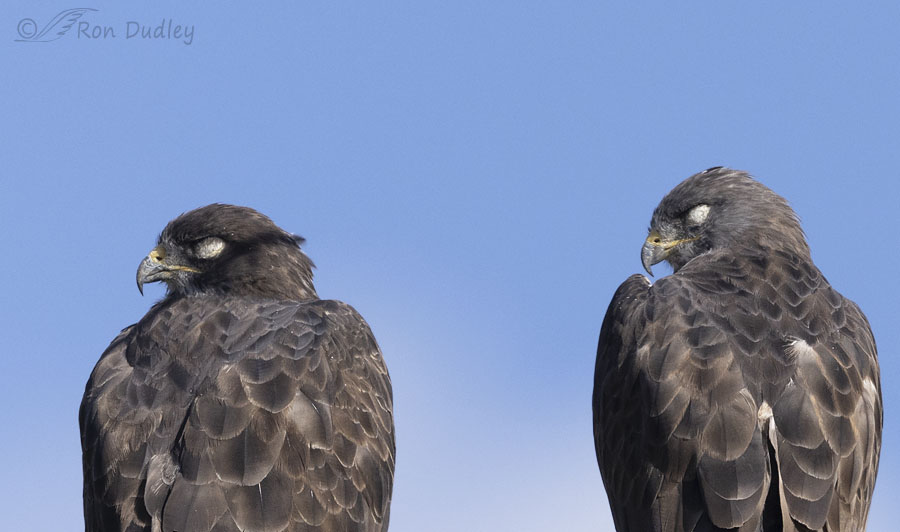
A closer look.
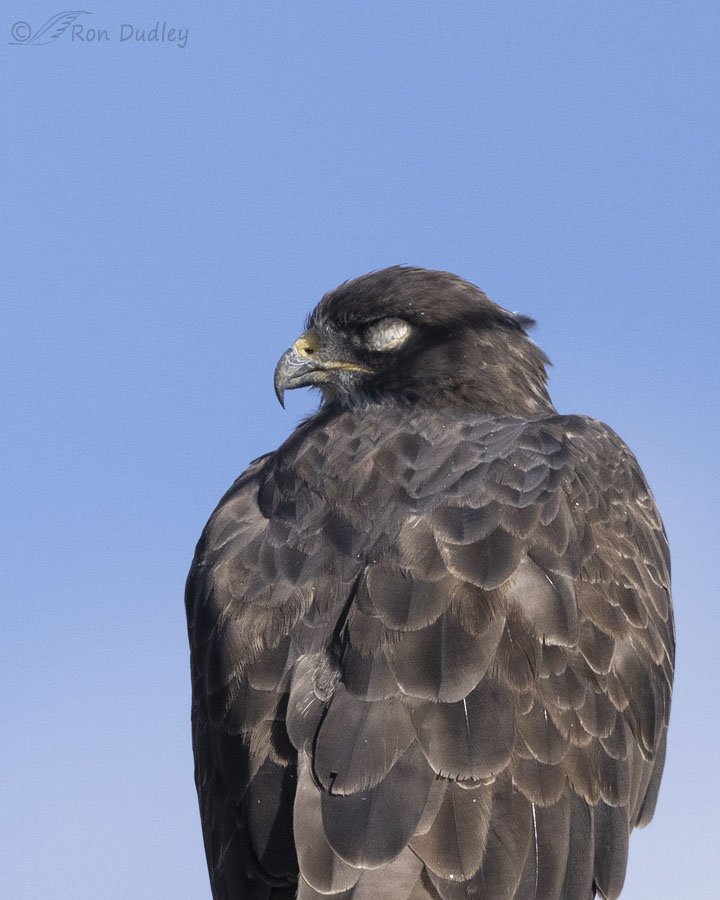
An even closer look at the bird on the left.
It was at that point that I suspected, despite the fact that I never did see the right eye of either bird, that they were sleeping unihemispherically.
“Unihemispheric slow-wave sleep (USWS) is sleep where one half of the brain rests while the other half remains alert. This is in contrast to normal sleep where both eyes are shut and both halves of the brain show unconsciousness. In USWS, also known as asymmetric slow-wave sleep, one half of the brain is in deep sleep, a form of non-rapid eye movement sleep and the eye corresponding to this half is closed while the other eye remains open. The phenomenon has been observed in a number of terrestrial, aquatic and avian species.”
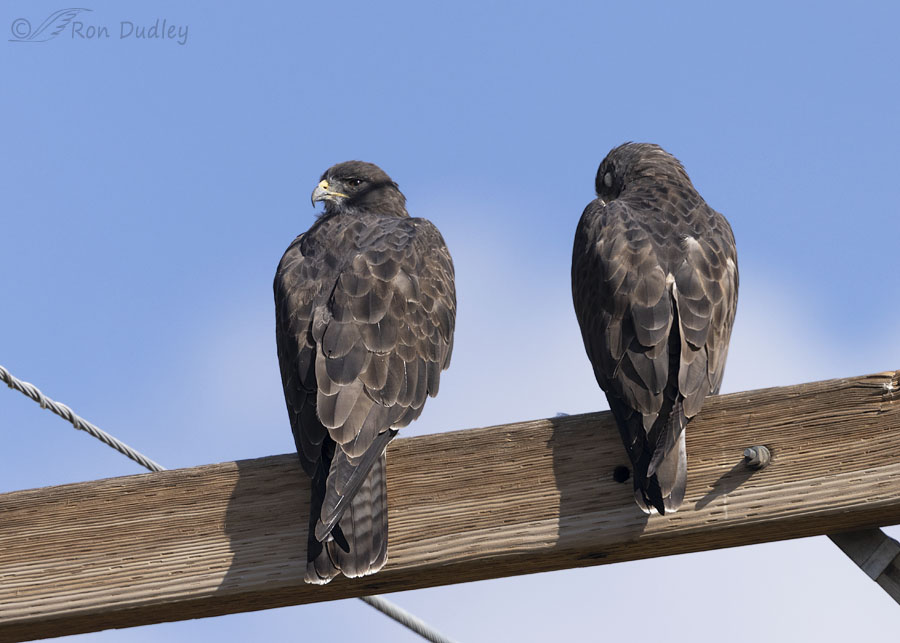
Occasionally both birds would open their eye that had been closed, probably to check me out. I’m including this photo so you can see that the bird on the left could open its eye normally, strongly implying that it wasn’t injured. The same thing can be seen with the hawk on the right in photo #1.
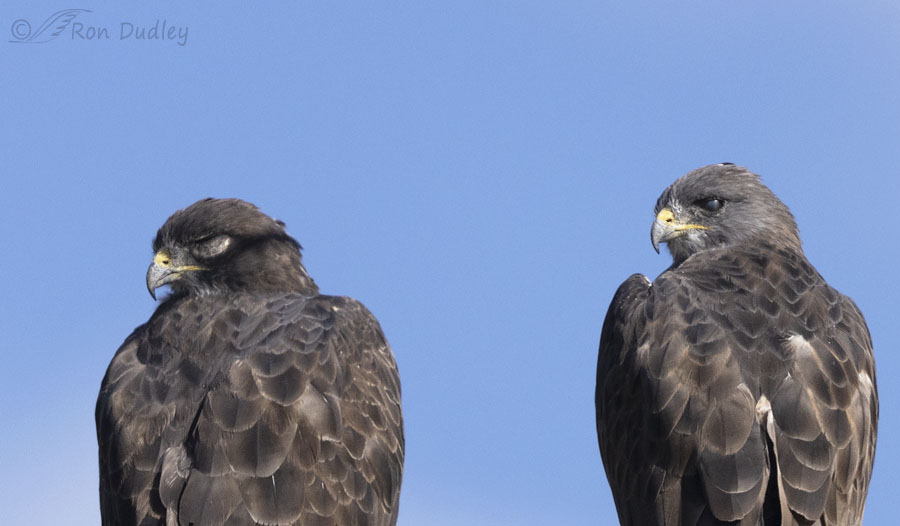
I’m including this last photo to document how different the transparent nictitating membrane looks when compared to the completely opaque true eyelid. Here the nictitating membrane of the hawk on the right is closed, which diffuses the catch light across a much larger area of the eye than is normal for a catch light.
Again, I never did see the right eye of either bird so I can’t prove that they were sleeping hemispherically but I strongly suspect that they were. Either way, it was highly unusual for me to photograph two raptors that were keeping their true eyelid closed at the same time so I think that’s interesting in and of itself.
If you have thoughts on this I welcome your input in the comments. I’m certainly no expert on unihemispheric sleep.
Ron


I love learning new things! Thank you!
Pat L
I meant to post this earlier but a blood vessel ruptured in my already bad eye so until it clears in a few days it’s like looking through glass smeared with Vaseline. Unfortunately, it was the better of my two bad eyes. So forgive any typos. I can’t see them.
There is an excellent book published many years ago called Birds Asleep by Alexandr Skutch that talks about this and other issues with sleep in birds. If you can find it it may help with some of the questions everyone has.
Dang, so very sorry about your eye, Dan. That’s all you need. I’ll fix your typos. I’ll be your eyes today…
Thanks for the heads up about the book.
Fascinating! Rattling around somewhere in my brain is something I read about a whole line of birds (ducks/geese?) sleeping, with the two outer critters guarding the flock and doing this USWS with the inside eye. So all the inside critters are sleeping soundly, and the two end critters are watching with their outside eyes, and sleeping with their inside eyes. And then the line will shift so the outer ones move to the inside and can totally sleep while completely rested birds become the end guards. I have no idea where I got this, but I’m pretty sure I didn’t make it up! Ooo, time to research!
Carolyn, if you find the source, please share it here. I’d like to read it.
I’ve seen and photographed this several times in ducks resting along the shoreline. Often the closed eye will pop open briefly when I’m near to assess any danger but the head often stays tucked down. If not alarmed, the eye re-shuts. but if they seem unsure, the head pops up and the bird becomes very alert.
Agreed, Dan. I think I’ve seen this behavior more often in ducks than I have in any other bird group.
You claim that you are not an expert but you certainly have a lot of knowledge. I like several others have never heard of (USWS) before and love learning something new. Thank you for all your time and effort in educating us still.
“You claim that you are not an expert but you certainly have a lot of knowledge”
Betty, in many cases it’s more a matter of me knowing how to Find the answer, than it is that I already know the answer.
Fascinating. I had read that some birds slept while flying during long migrations but didn’t know how they managed it. That they can do it, at will, anytime, anywhere is even more fascinating. There is definitely more to bird photography here at FP than just “pretty”.
I especially appreciate your last sentence, Granny Pat. Thank you.
That is interesting, wondered how they managed long migration flights. That maybe it. Too bad humans can’t do it on the interstates, there are times I could do with a nap while driving instead of stopping..
Jo, I think some drivers DO do it on the interstates. Or at least try to.
Fascinating series. I knew about unihemispheric sleep in birds, but have wondered if they alternate which side of their brain goes to sleep. I’ve looked quite a bit on the Net and consulted some bird researches, but haven’t found an answer. By any chance do you know?
“wondered if they alternate which side of their brain goes to sleep”
Kent, I think this, from the Wikipedia article I linked to in my post, at least implies that they can.
“On land, birds can switch between sleeping with both hemispheres to one hemisphere.”
Unihemispheric slow-wave sleep. Wow. New one for me. Thank you professor for anther lesson. For most people, the case may have been more convincing had we seen the right eyes. However, I have never seen a hawk seep with both eyes shut and their head turned like that. It may be that most of my experience was with hawks that I have flown in the practice of falconry, but the hawks I have been familiar with have always tucked their heads between their wings when sleeping (both eyes shut), even with a hood on.
Interesting that they would tuck their head even with the hood on. Thanks for that insight, Michael.
Fascinating. Thanks, Ron!
Thank you, Kathryn.
I would really like to know how behavioral scientists were able to
study this behavior– surely it COULDN’T be verified in animals
which were anesthetized ? How could it be studied ? Strictly by
observation in the wild ? I’m fascinated– thanks for this post…..
Good question, Kris. I have several guesses but that’s all they would be – guesses.
Interesting! Suspect you’re correct since neither moved other than opening/closing their eye! I’ve heard of Unihemispheric sleep tho never witnessed it.
Judy, I’ve witnessed it a number of times but what I thought was special was getting photos of two hawks doing it at the same time in the same photo.
Unihemispherically. Wow Ron, another educational moment for me. For sure have never heard that word. My spell check here is not even up for it. I don’t like taking photos of birds on poles either, but if I saw 9 Swainson’s Hawks on poles with or without sleeping I for sure would be taking photos. The unihemispheric sleeping is an added bonus. We are all familiar with the nictitating membrane in birds, but seeing this behavior would certainly get my attention.
Thanks for posting this.
As this behavior is described it would be much like exhausted soldiers in fox holes during days of combat asleep but awake.
Thanks, Everett. Interesting comparison with exhausted soldiers.
Love that you never stop teaching. Thanks!
Can’t help myself, Burrdoo.
Thanks for the avian sleep study lesson. I’m not sure I remember knowing the term for the sleeping on one side of the brain. It seems humans at times are also half asleep.
“It seems humans at times are also half asleep.”
Brett, as I’m sure you remember, half-asleep students in early morning classes are far from unusual.
How absolutely fascinating. I do love learning new things and am so glad that you captured and shared this. I had never even heard of unihemispheric sleep let alone seen photos.
Glad to know you enjoyed learning something new, EC. But then you always seem to enjoy it. Thanks.